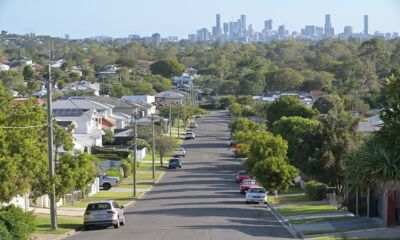Property market cycles in Australia
Australia’s property market is often described as being cyclical in nature. So what is the property cycle in Australia and how does it work?

Australia’s property market is often described as being cyclical in nature. So what is the property cycle in Australia and how does it work?
Having an idea of how the property market functions can be crucial for all homeowners, from first home buyers to seasoned investors. As with any investment, they’ll generally be times more suited to buying, holding or selling. As far as property is concerned, this is usually referred to as the property market cycle.
The property cycle in Australia is driven by several factors, such as supply and demand, interest rates, consumer confidence, economic conditions and government policy.
Compare home loans for first home buyers
What is a property cycle in Australia?
While some commentators refer to a ‘seven-year property cycle’ to explain how house prices often move through the four phases, these property cycles vary in length and aren’t really dependent on a length of time, but more on a range of socioeconomic factors.
A simplistic version of the property cycle looks like this: as our population increases, so does the demand for real estate—both for rental properties from investors and new and existing properties from owner-occupiers.
This slowly causes property values to increase because of the economic forces associated with supply and demand. If demand is higher than supply, generally the price of the asset will increase.
At the same time, builders and developers start constructing new dwellings to meet this increased demand. They can, however, be hampered by supply chain issues and job market constraints, such as those caused by the COVID-19 pandemic.
Over time supply generally begins to outpace demand and Australia usually ends up with an oversupply of dwellings. This oversupply can eventually result in slumping home values and rent reductions.
What are the different phases of a property cycle?
There are four key phases of a property cycle being the boom phase, the downturn phase, the stabilisation phase and the upturn phase.
The boom phase
This tends to be the shortest phase of a cycle. During the boom stage, real estate prices increase rapidly—often by more than 20% each year.
Each boom brings a whole new generation of investors into the market and at the same time, would-be homeowners push up demand for houses. Together this leads to increasing property prices, which is usually to the benefit of investors and existing homeowners. Builders and developers generally then flood the market with new properties to meet the increasing demand.
The downturn phase
Booms are generally followed by a downturn or slump phase that is often characterised by an oversupply of properties, due to the over-exuberant activity of builders and developers during the preceding boom. This can result in increased vacancy rates and decreasing rental prices, as renters and first home buyers have more options to choose from. Property prices tend to stop growing and can sometimes drop by around 10% or so in this phase. This phase can sometimes leave borrowers with new home loans with negative equity in their property.
The downturn phase typically lasts a number of years, but prolonged booms may be followed by longer and deeper downturn phases, with a greater likelihood of prices falling further.
The stabilisation phase
Eventually, the market stabilises. Falling interest rates and rising demand set the stage for the next property upturn.
But prices generally don’t suddenly start escalating wildly. Buyers tentatively move back into the market, but since the number of buyers and sellers is in rough equilibrium, property prices remain flat or only move up slowly. This can be a time of great opportunity, yet it’s not easily recognised by most homeowners or investors.
The upturn phase
In time the cycle moves into the upturn phase when vacancy rates typically slowly fall, rents start to rise and property values begin to increase again.
At this stage of the cycle (which could last three or four years) property is generally affordable, returns from property investments can be attractive and more home buyers and investors begin to enter the market. This is also when many builders and developers begin work on new projects, aiming to have them completed by the late upturn or boom phase of the cycle.
At the end of the upturn phase, real estate prices will have risen substantially and property starts to become less affordable for many Australians. This is where the cycle begins again.
How long do property cycles usually last?
A property cycle doesn’t necessarily last a fixed period of time. But looking back over recent decades, property growth in Australia has peaked in the following years: 1981, 1987, 1994, 2003, 2010, 2017 and 2022. It’s easy to see why some people feel property cycles in Australia last around seven years.
And digging deeper into the stats, it’s clear that over the past 40 years, well-located capital city properties have seen their values double every 10 years or so. However, at some stages of the cycle values increase, and at other times they stay flat or decrease.
And while most cycles do seem to last between seven and nine years, the length of a particular property cycle can be affected by a combination of factors such as the state of the economy, as well as social and political issues. Then, at times, the government lengthens or shortens the cycle by changing economic and tax policies while the RBA makes decisions whether to cut, hold or raise the cash rate, which in turn affects interest rates. This can either encourage or discourage consumers from borrowing and spending.
For example, the most recent property boom phase, which ended around early 2022, was prolonged by a lengthy period of falling interest rates. It eventually came to an end as affordability dropped, exacerbated by a lack of new properties being built, as well as the 13 interest rate rises from May 2022 to November 2023.
Does all of Australia follow the same property cycle?
While many people make generalisations about the ‘singular Australian property market’, there are many markets within it, often called ‘submarkets’.
The fact is, each state and territory can be at a different stage of its own property cycle. Even the different regions in these submarkets are themselves segmented by geography, price points and the types of property available.
For example, the more expensive end of the market will tend to perform differently to the new home buyer’s market, which is different again from the investor segment or the established property sector.
Although different states and territories are usually at different stages of their own cycles, during the last property boom almost every property in Australia increased in value. Each of these submarkets, however, are influenced depending on their local economic conditions, population growth/decline and supply and demand for properties.
What else should I know about property cycles?
Our property markets and the fluctuations of the property cycle can also be driven by emotional responses, says Michael Yardney, the founder of Metropole Property Strategists and an Australian property commentator.
He said this was evident during the last boom, as rising property values created FOMO—the fear of missing out. With interest rates now easing, many homebuyers and investors may enter the market due to this FOMO as they chase future capital growth.
The Australian property markets may often ‘overshoot’. That is, they move more drastically than the fundamental influences would seem to require—on the upside as well as the downside. These larger swings are often driven by ‘herd mentality’, which can influence people’s home-buying decisions, often to their detriment.
Home buyers and investors tend to be at their most optimistic near the peak of a property cycle, at a time when they should be the most cautious. They’re also the most pessimistic when media outlets espouse the doom and gloom of the bottom of the cycle, when there could be the least risk involved.
The fact is, market sentiment is one of the key drivers of property cycles and one of the reasons why our markets tend to overreact, overshooting the mark during booms and falling deeper during slumps.
During the boom phase of the property cycle, home buyers and investors experience FOMO as they see property prices going up all around them. They’re worried that they may miss out on the profits the boom has delivered to other property owners.
On the other hand, during the downturn phase of the cycle the opposite occurs—FOBE (Fear of Buying Early) says Mr. Yardney. This assumption that the slump in values could continue and prices could drop even further stops many homebuyers and investors from taking a chance on a property at the time.
Due to the cyclical nature of Australia’s property cycle, each boom sets Australia up for the next downturn, just as each downturn sets the scene for the next upturn. The good news is property value slumps are only temporary, while the long-term escalation of property values in our capital cities is seemingly more permanent.
If you’re looking to enter the property market, you may like to compare home loans with Canstar. It’s important to read all relevant documentation, such as the Product Disclosure Statement (PDS) and Target Market Determination (TMD), for any loan product you are considering. Since taking out a home loan is a big financial commitment, it’s recommended to seek out professional financial advice before doing so.
The comparison rate for all home loans and loans secured against real property are based on secured credit of $150,000 and a term of 25 years.
^WARNING: This comparison rate is true only for the examples given and may not include all fees and charges. Different terms, fees or other loan amounts might result in a different comparison rate.
 Owner occupied
Owner occupied
 20% min deposit
20% min deposit
 Redraw facility
Redraw facility
 Owner occupied
Owner occupied
 10% min deposit
10% min deposit
 Redraw facility
Redraw facility
 Owner occupied
Owner occupied
 20% min deposit
20% min deposit
 Redraw facility
Redraw facility
Canstar may earn a fee for referrals from its website tables, and from Sponsorship or Promotion of certain products. Fees payable by product providers for referrals and Sponsorship or Promotion may vary between providers, website position, and revenue model. Sponsorship or Promotion fees may be higher than referral fees. Sponsored or Promoted products are clearly disclosed as such on website pages. They may appear in a number of areas of the website such as in comparison tables, on hub pages and in articles. Sponsored or Promoted products may be displayed in a fixed position in a table, regardless of the product’s rating, price or other attributes. The table position of a Sponsored or Promoted product does not indicate any ranking or rating by Canstar. For more information please see How We Get Paid.
Cover image source: ChameleonsEye/Shutterstock.com
This article was reviewed by our Finance Editor Jessica Pridmore before it was updated, as part of our fact-checking process.

The comparison rate for all home loans and loans secured against real property are based on secured credit of $150,000 and a term of 25 years.
^WARNING: This comparison rate is true only for the examples given and may not include all fees and charges. Different terms, fees or other loan amounts might result in a different comparison rate.
 Owner occupied
Owner occupied
 40% min deposit
40% min deposit
 Redraw facility
Redraw facility
Try our Home Loans comparison tool to instantly compare Canstar expert rated options.
The comparison rate for all home loans and loans secured against real property are based on secured credit of $150,000 and a term of 25 years.
^WARNING: This comparison rate is true only for the examples given and may not include all fees and charges. Different terms, fees or other loan amounts might result in a different comparison rate.






